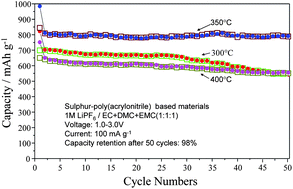Analysis of the synthesis process of sulphur–poly(acrylonitrile)-based cathode materials for lithium batteries
Abstract
Li/S batteries have attracted great attention in the last twenty years, as they offer the advantage of high gravimetric energy densities over the current conventional Li-ion systems. Besides elemental sulphur based composites, sulphur–poly(acrylonitrile)-based materials are promising candidates for Li/S batteries. Though the structure of the sulphur–poly(acrylonitrile)-based material is still debated, the effects of the synthesis conditions on the material structure, and thus on the electrochemical performance, are undoubted. Here the synthesis process of sulphur–poly(acrylonitrile)-based material is probed by


 Please wait while we load your content...
Please wait while we load your content...